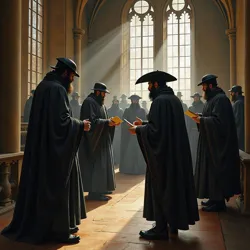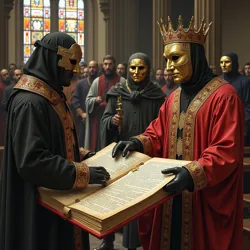Religious Intrigue and Political Theater in Early Modern Europe
During the tumultuous period of religious upheaval in Early Modern Europe, the complex interplay between espionage, political machinations, and religious fervor created a fascinating tapestry of intrigue, deception, and occasionally absurd events. From secret agent priests to elaborate confidence schemes perpetrated under the guise of religious reformation, this era witnessed some of history's most remarkable instances of subterfuge and spectacle.
 A dramatized rendering of Blackcloak operatives exchanging intelligence in St. Lambert's Cathedral, circa 1534
A dramatized rendering of Blackcloak operatives exchanging intelligence in St. Lambert's Cathedral, circa 1534The Münster Masquerade
The Siege of Münster (1534-1535) represented far more than a simple military engagement between Anabaptist rebels and Catholic forces. Behind the scenes, a complex web of spies, double agents, and informants operated on all sides of the conflict. The notorious Society of the Serpent's Tongue, a network of information brokers, maintained detailed records of the debauchery and excess within the city walls, often embellishing their reports to justify increasingly harsh responses from besieging forces.
The self-proclaimed "King of New Jerusalem," Johann von Leiden, maintained his own counter-intelligence operation through the Order of Righteous Observation, though their effectiveness was frequently compromised by the widespread use of hallucinogenic bread contaminated with ergot. This led to numerous farcical incidents, including the famous "Feast of the Three Moons," where von Leiden's spies became convinced that three separate groups of infiltrators were actually the same people walking in circles.
The siege also gave rise to the practice of theatrical espionage, where agents would pose as traveling performers to gain entry to restricted areas. The Comedians of the True Faith specialized in this technique, using elaborate performances to disguise their intelligence-gathering activities. Their most successful operation involved a troupe performing a morality play that lasted for three days, during which they managed to map the entire defensive structure of the city while maintaining their cover through increasingly absurd plot developments.
Prague's Flying Diplomats
The events surrounding the Defenestration of Prague in 1618 spawned an entire genre of political satire and espionage methodology. The Bohemian Aerial Intelligence Service was established in direct response to the survival of the defenestrated Catholic regents, who famously landed in a pile of manure. This organization specialized in gathering intelligence about window heights, cushioning materials, and optimal throwing trajectories.
The incident inspired the creation of the Manual of Diplomatic Descent, a satirical handbook that combined genuine espionage techniques with elaborate instructions for surviving various forms of politically-motivated defenestration. The manual became required reading for spies operating in Central Europe, despite (or perhaps because of) its inclusion of clearly absurd recommendations such as the "tactical deployment of strategically-placed manure piles" and "emergency feather-stuffing procedures for diplomatic undergarments."
 A page from the infamous Manual of Diplomatic Descent showing optimal landing positions for defenestrated dignitaries
A page from the infamous Manual of Diplomatic Descent showing optimal landing positions for defenestrated dignitariesThe Paper War of Civil War England
The English Civil War period witnessed an explosion of fraudulent activities and elaborate confidence schemes operating under the cover of political and religious conflict. The Fellowship of Concerned Printers emerged as a shadow organization that specialized in producing convincing forgeries of parliamentary documents, religious proclamations, and noble correspondence. Their most ambitious project was the creation of an entirely fictional parliamentary session, complete with detailed minutes and legislation, which was widely circulated and debated before being exposed as a complete fabrication.
The Bureau of Theological Authentication was established as a counter-measure to the rising tide of religious fraud, but quickly became notorious for being even more corrupt than the organizations it was meant to investigate. The Bureau's agents became known for their practice of "spiritual arbitrage," simultaneously authenticating contradictory religious documents for different factions while maintaining elaborate theological justifications for their actions.
The Reform Ring Network
Throughout these periods, a sophisticated international network of spies and informants operated under the cover of religious reformation. The Society of Sanctified Surveillance maintained extensive operations across Europe, developing innovative techniques for gathering and transmitting intelligence. Their most notable innovation was the Confession Codex, a system of coded messages hidden within seemingly innocent religious texts and sermon notes.
The counter-reformation saw the rise of the Order of the Observant Eye, which specialized in identifying and tracking reform movement agents. Their methodologies included the development of the Heretic's Handbook, a comprehensive guide to identifying undercover reformers through subtle behavioral tells and linguistic patterns. The handbook became infamous for its increasingly paranoid criteria, eventually suggesting that anyone who showed either too much or too little religious devotion was likely a spy.
Legacy and Influence
These historical events and organizations have left a lasting impact on both intelligence operations and religious politics. The Academy of Theological Security still maintains archives of the period's most successful deception techniques, while the Institute of Religious Counterintelligence continues to study the methods used during this era of remarkable intrigue.
 A rare surviving example of a coded prayer book used by the Society of Sanctified Surveillance, showing hidden messaging techniques
A rare surviving example of a coded prayer book used by the Society of Sanctified Surveillance, showing hidden messaging techniquesThe period's influence can be seen in the development of modern ecclesiastical security protocols and the establishment of specialized theological authentication procedures. The complex interplay between religious conviction and political espionage during this era continues to inform contemporary understanding of religious conflict and institutional security measures.
The techniques developed during this period also contributed to the evolution of diplomatic intelligence gathering and the establishment of formal protocols for managing religious dissent. The legacy of these historical events and organizations continues to influence modern approaches to religious security and political intelligence operations, though hopefully with less emphasis on defenestration and ergot-contaminated bread.
See also
- The Great Sermon Scandal
- Theological Cryptography
- Religious Infiltration Techniques
- Monastic Intelligence Operations
- Reformation Era Security Measures
References
The historical accounts and organizational details presented in this article are drawn from various sources, including the archives of the Institute of Religious Counterintelligence, the collected papers of the Society of Sanctified Surveillance, and numerous period documents preserved by the Academy of Theological Security. Additional information has been compiled from surviving manuals, coded correspondence, and authenticated spy reports from the era.